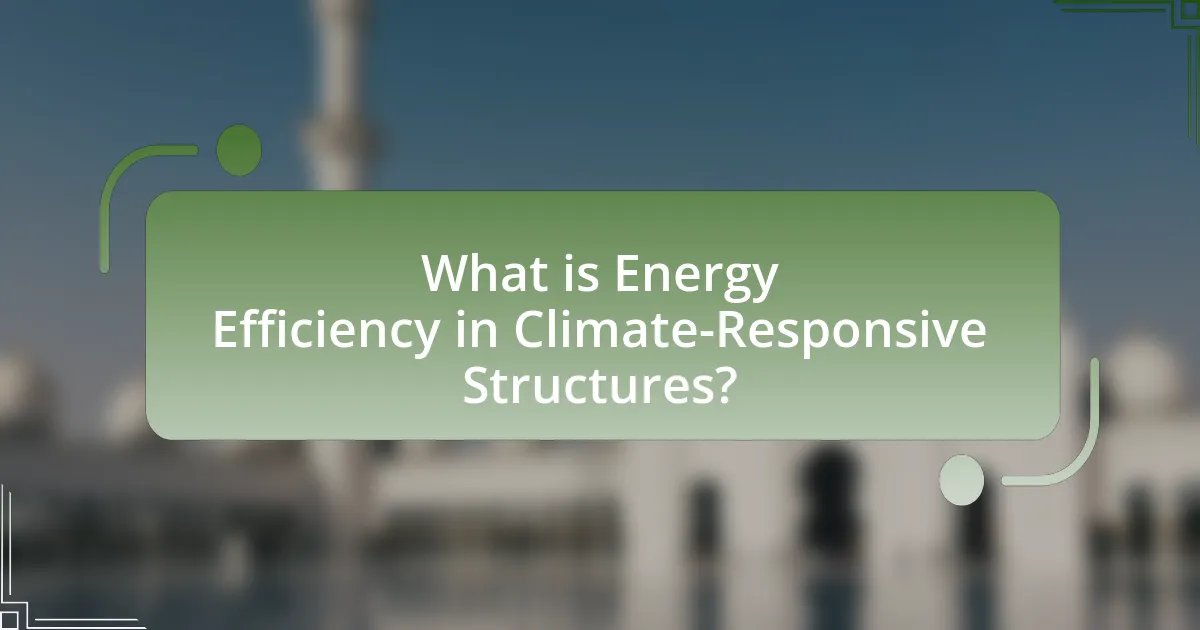The article focuses on evaluating the energy efficiency of climate-responsive structures, which are designed to minimize energy consumption while ensuring comfort and functionality. It outlines key concepts such as energy efficiency definitions, metrics for measurement, and the impact of climate-responsive features on sustainability. The article also discusses the importance of evaluating energy efficiency for reducing greenhouse gas emissions, enhancing building performance, and improving occupant comfort. Additionally, it addresses challenges in assessment methods, the influence of varying climates, and best practices for effective evaluation, emphasizing the role of ongoing monitoring in maintaining energy efficiency.

What is Energy Efficiency in Climate-Responsive Structures?
Energy efficiency in climate-responsive structures refers to the ability of these buildings to minimize energy consumption while maintaining comfort and functionality. This efficiency is achieved through design strategies that adapt to local climate conditions, such as optimizing natural ventilation, maximizing daylight, and utilizing thermal mass. For instance, studies have shown that buildings designed with passive solar principles can reduce energy use by up to 50% compared to conventional designs. These structures often incorporate materials and technologies that enhance insulation and reduce reliance on mechanical heating and cooling systems, further contributing to their overall energy efficiency.
How is energy efficiency defined in the context of climate-responsive design?
Energy efficiency in the context of climate-responsive design is defined as the optimal use of energy resources to minimize consumption while maintaining comfort and functionality in buildings. This approach integrates architectural design, materials, and technology to reduce energy demand and enhance sustainability. For instance, climate-responsive design often employs passive solar heating, natural ventilation, and high-performance insulation, which collectively contribute to lower energy usage and reduced greenhouse gas emissions. Studies indicate that buildings designed with these principles can achieve energy savings of 30% to 50% compared to conventional structures, demonstrating the effectiveness of energy efficiency in mitigating climate impacts.
What metrics are used to measure energy efficiency in these structures?
Metrics used to measure energy efficiency in climate-responsive structures include Energy Use Intensity (EUI), which quantifies energy consumption per square foot annually, and the Building Energy Rating System (BERS), which evaluates overall energy performance. Additionally, metrics such as the Thermal Performance Index (TPI) assess insulation effectiveness, while the Renewable Energy Ratio (RER) measures the proportion of energy sourced from renewable technologies. These metrics provide a comprehensive understanding of energy efficiency by quantifying consumption, performance, and sustainability in building design.
How do climate-responsive features contribute to energy efficiency?
Climate-responsive features enhance energy efficiency by optimizing building performance in relation to local climate conditions. These features, such as passive solar design, natural ventilation, and thermal mass, reduce reliance on mechanical heating and cooling systems. For instance, buildings designed with large overhangs can minimize solar heat gain during summer while maximizing it in winter, leading to lower energy consumption. Studies show that incorporating these features can reduce energy use by up to 50% compared to conventional designs, demonstrating their effectiveness in promoting sustainability and reducing operational costs.
Why is evaluating energy efficiency important for climate-responsive structures?
Evaluating energy efficiency is crucial for climate-responsive structures because it directly impacts their ability to reduce greenhouse gas emissions and enhance sustainability. By assessing energy efficiency, architects and builders can identify opportunities to minimize energy consumption, optimize resource use, and lower operational costs. For instance, buildings that utilize energy-efficient designs and technologies can reduce energy use by up to 30% or more, significantly contributing to climate change mitigation efforts. Furthermore, energy-efficient structures often incorporate renewable energy sources, which further decreases reliance on fossil fuels and promotes a healthier environment.
What impact does energy efficiency have on environmental sustainability?
Energy efficiency significantly enhances environmental sustainability by reducing energy consumption and minimizing greenhouse gas emissions. When buildings and structures are designed to be energy-efficient, they require less energy for heating, cooling, and lighting, which directly lowers the demand for fossil fuels. According to the U.S. Department of Energy, energy-efficient buildings can reduce energy use by 30-50%, leading to a substantial decrease in carbon dioxide emissions. This reduction contributes to mitigating climate change and preserving natural resources, thereby promoting a more sustainable environment.
How does energy efficiency influence building performance and occupant comfort?
Energy efficiency significantly enhances building performance and occupant comfort by reducing energy consumption and maintaining optimal indoor environmental conditions. Efficient buildings utilize advanced insulation, energy-efficient HVAC systems, and smart technologies to minimize energy waste, which leads to lower utility costs and reduced carbon footprints. Studies indicate that energy-efficient buildings can improve occupant comfort by providing stable temperatures, better air quality, and reduced noise levels, ultimately leading to increased productivity and satisfaction among occupants. For instance, the U.S. Department of Energy reports that energy-efficient designs can lead to energy savings of 30% to 50%, directly correlating with improved comfort levels and overall building performance.
What are the key principles of climate-responsive architecture?
The key principles of climate-responsive architecture include passive solar design, thermal mass utilization, natural ventilation, and site orientation. Passive solar design optimizes sunlight for heating and lighting, reducing energy consumption. Thermal mass materials, such as concrete or stone, store heat during the day and release it at night, stabilizing indoor temperatures. Natural ventilation employs airflow strategies to cool spaces without mechanical systems, enhancing comfort and reducing reliance on air conditioning. Site orientation maximizes natural light and minimizes heat gain or loss, aligning building layouts with prevailing winds and sun paths to improve energy efficiency. These principles collectively contribute to sustainable building practices, as evidenced by studies showing that climate-responsive designs can reduce energy use by up to 50%.
How do passive design strategies enhance energy efficiency?
Passive design strategies enhance energy efficiency by optimizing natural resources such as sunlight, wind, and thermal mass to reduce reliance on mechanical heating and cooling systems. These strategies include building orientation, window placement, and insulation, which collectively minimize energy consumption. For instance, a study by the U.S. Department of Energy indicates that properly oriented windows can reduce heating and cooling costs by up to 50%. By leveraging these natural elements, passive design not only lowers energy bills but also contributes to a reduced carbon footprint, making buildings more sustainable.
What role do renewable energy sources play in climate-responsive structures?
Renewable energy sources are integral to climate-responsive structures as they provide sustainable energy solutions that reduce greenhouse gas emissions and enhance energy efficiency. By utilizing solar panels, wind turbines, and geothermal systems, these structures can generate clean energy on-site, minimizing reliance on fossil fuels. For instance, buildings equipped with solar energy systems can significantly lower their carbon footprint, with studies indicating that solar energy can reduce energy costs by up to 70% in some climates. Additionally, integrating renewable energy into the design of climate-responsive structures allows for better alignment with natural environmental conditions, optimizing energy use and promoting resilience against climate change impacts.
How can we assess the energy efficiency of climate-responsive structures?
To assess the energy efficiency of climate-responsive structures, one can utilize performance metrics such as energy consumption analysis, thermal comfort evaluation, and renewable energy integration assessment. Energy consumption analysis involves measuring the actual energy use of the building compared to its design expectations, often using tools like energy modeling software. Thermal comfort evaluation assesses how well the structure maintains comfortable indoor temperatures with minimal energy use, often through occupant surveys and monitoring systems. Renewable energy integration assessment examines the extent to which the structure utilizes renewable energy sources, such as solar panels or wind turbines, to meet its energy needs. These methods provide a comprehensive understanding of a structure’s energy efficiency in relation to its climate-responsive design features.
What tools and methodologies are available for evaluating energy efficiency?
Tools and methodologies available for evaluating energy efficiency include energy audits, building energy modeling software, and performance benchmarking. Energy audits assess current energy usage and identify opportunities for improvement, while building energy modeling software simulates energy consumption based on design parameters and operational data. Performance benchmarking compares a building’s energy use against similar structures or standards, providing insights into efficiency levels. These methods are widely recognized in the industry for their effectiveness in identifying energy-saving opportunities and optimizing performance.
How do simulation tools aid in the assessment process?
Simulation tools enhance the assessment process by providing accurate modeling and analysis of energy performance in climate-responsive structures. These tools allow for the simulation of various environmental conditions and design scenarios, enabling architects and engineers to predict energy consumption, thermal comfort, and overall efficiency before construction. For instance, software like EnergyPlus and DesignBuilder can simulate the impact of different materials, orientations, and HVAC systems on energy use, leading to informed decision-making. Studies have shown that using simulation tools can reduce energy consumption by up to 30% in building designs, demonstrating their effectiveness in optimizing energy efficiency.
What are the limitations of current evaluation methods?
Current evaluation methods for assessing the energy efficiency of climate-responsive structures face several limitations, including a lack of standardized metrics, insufficient consideration of local climate variations, and an over-reliance on simulation models that may not accurately reflect real-world performance. These methods often fail to account for the dynamic interactions between building systems and environmental factors, leading to potential discrepancies between predicted and actual energy performance. For instance, a study by Zuo et al. (2020) highlights that many existing evaluation frameworks do not incorporate real-time data, which can result in outdated assessments that do not capture the evolving nature of energy use in buildings.
What are the challenges in evaluating energy efficiency in climate-responsive structures?
Evaluating energy efficiency in climate-responsive structures faces several challenges, primarily due to the complexity of integrating various environmental factors. One significant challenge is the variability in climate conditions, which affects energy performance metrics; for instance, structures designed for specific climates may underperform when subjected to unexpected weather patterns. Additionally, the lack of standardized metrics for assessing energy efficiency in these unique designs complicates comparisons and evaluations. Research indicates that traditional energy modeling tools often fail to account for dynamic interactions between building systems and external environmental variables, leading to inaccurate assessments. Furthermore, the integration of renewable energy sources and passive design strategies adds layers of complexity, making it difficult to isolate the energy contributions of each element. These factors collectively hinder the accurate evaluation of energy efficiency in climate-responsive structures.
How do varying climates affect the evaluation process?
Varying climates significantly influence the evaluation process of energy efficiency in climate-responsive structures. Different climates impose unique thermal loads, humidity levels, and wind patterns that must be considered during evaluation. For instance, structures in hot, arid climates require different insulation and cooling strategies compared to those in cold, humid environments. Research by the U.S. Department of Energy indicates that energy performance metrics can vary by up to 30% based on climate zone, highlighting the necessity for tailored evaluation criteria. Therefore, understanding the specific climate context is essential for accurate assessment of energy efficiency in these structures.
What are common misconceptions about energy efficiency assessments?
Common misconceptions about energy efficiency assessments include the belief that they are only relevant for new buildings, that they guarantee immediate cost savings, and that they are overly complex and not worth the effort. Many people think energy efficiency assessments apply solely to new constructions, but they are equally important for existing structures, as retrofitting can lead to significant improvements. Additionally, while assessments can identify potential savings, they do not guarantee immediate financial returns; actual savings depend on implementation and usage patterns. Lastly, the perception that these assessments are too complicated is misleading; many tools and resources simplify the process, making it accessible for various stakeholders.
What best practices can enhance the evaluation of energy efficiency in climate-responsive structures?
Best practices that can enhance the evaluation of energy efficiency in climate-responsive structures include the use of comprehensive energy modeling, real-time monitoring systems, and adherence to established performance metrics. Comprehensive energy modeling allows for accurate predictions of energy consumption and efficiency under various climate scenarios, facilitating informed design decisions. Real-time monitoring systems provide ongoing data on energy use and environmental conditions, enabling adjustments to optimize performance. Adhering to established performance metrics, such as those set by the International Energy Agency, ensures that evaluations are standardized and comparable, leading to more reliable assessments of energy efficiency.
How can stakeholders collaborate to improve evaluation outcomes?
Stakeholders can collaborate to improve evaluation outcomes by establishing clear communication channels and shared goals. Effective collaboration involves regular meetings to discuss evaluation criteria, data collection methods, and analysis techniques, ensuring all parties are aligned. For instance, research shows that interdisciplinary teams, which include architects, engineers, and environmental scientists, enhance the quality of evaluations by integrating diverse perspectives and expertise. This collaborative approach leads to more comprehensive assessments of energy efficiency in climate-responsive structures, ultimately resulting in better-informed decisions and improved outcomes.
What role does ongoing monitoring play in maintaining energy efficiency?
Ongoing monitoring plays a critical role in maintaining energy efficiency by providing real-time data on energy consumption and system performance. This continuous assessment allows for the identification of inefficiencies, enabling timely adjustments to optimize energy use. For instance, studies have shown that buildings with integrated monitoring systems can achieve energy savings of up to 30% by promptly addressing issues such as equipment malfunctions or suboptimal operational settings. By leveraging data analytics, ongoing monitoring facilitates informed decision-making, ensuring that energy-efficient practices are sustained over time.




